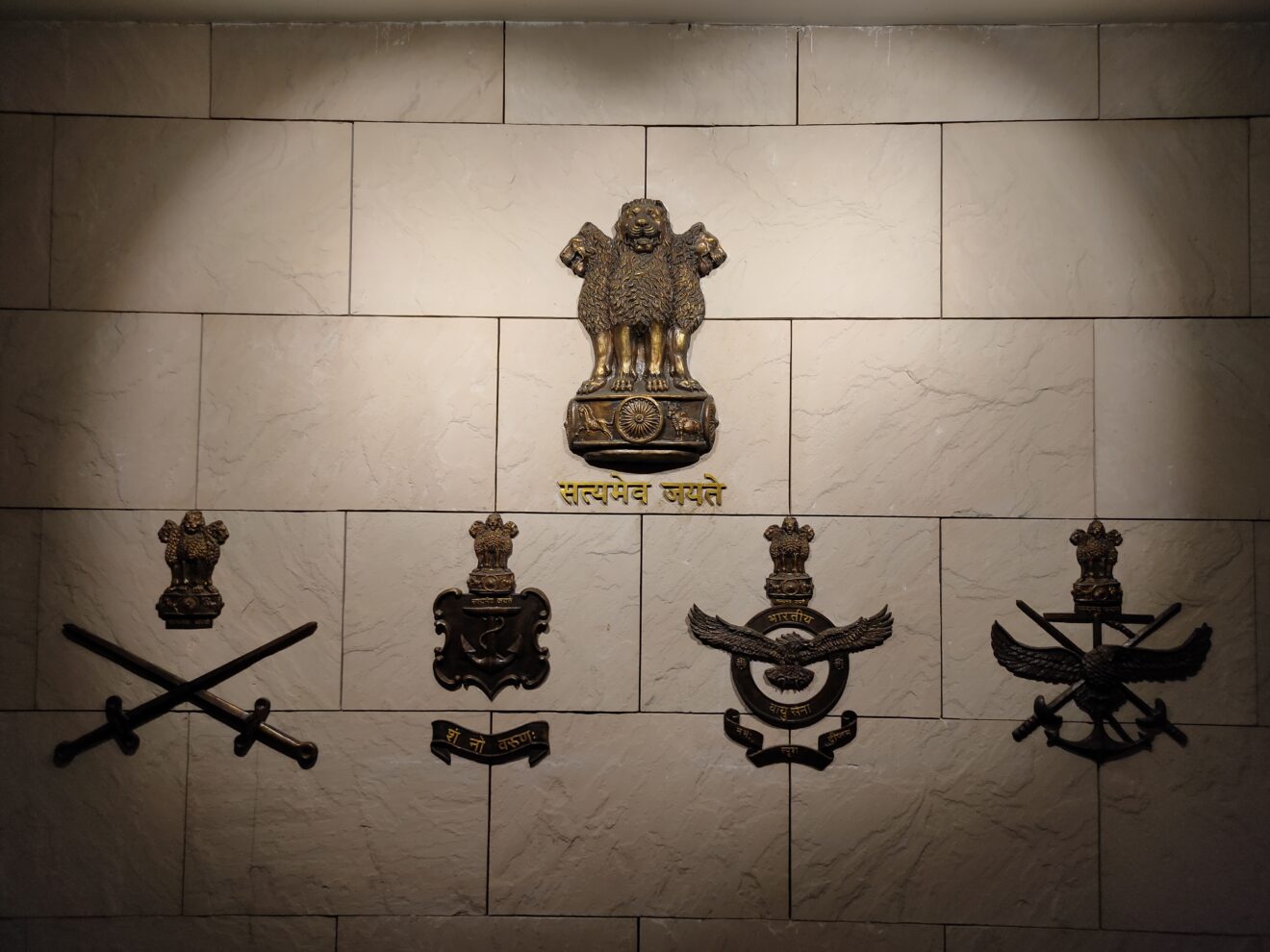BY DEFENCE JOURNALIST SAHIL | T.I.N. NETWORK
India Launches ‘Trishul’ — A Massive Tri-Service Exercise Along Pakistan Border to Test Post-Sindoor Combat Readiness
New Delhi, Saturday, 1 November 2025
In a major demonstration of India’s integrated combat capabilities and strategic preparedness, the Indian Armed Forces have launched ‘Exercise Trishul’, a 12-day tri-service war drill along the Pakistan border. The exercise, which began on 31 October, marks India’s first full-scale military manoeuvre since Operation Sindoor, held six months ago. It reflects New Delhi’s evolving doctrine of joint operations and high-tempo readiness amid sustained regional volatility.
Tri-Services in Action: Air, Land, and Sea Synchronisation
‘Trishul’ brings together the Indian Army, Navy, and Air Force in one of the most elaborate joint exercises in recent times. From the deserts of Rajasthan to the coastal and offshore zones of Gujarat, the exercise aims to simulate a multi-domain battlefield — integrating air superiority, ground thrusts, and maritime denial operations.
The Indian Air Force has deployed its frontline fighter assets including Rafale, Sukhoi Su-30MKI, Mirage-2000, and Jaguar aircraft, which will conduct coordinated strike and interdiction missions. Transport and surveillance platforms such as the C-130J Super Hercules, Netra AEW&C, and Heron drones will provide real-time situational awareness and target acquisition capabilities.
The Indian Navy, operating from the Western Naval Command, has mobilised surface warships, fast attack craft, and maritime patrol aircraft (P-8I) to enhance littoral surveillance and sea control near the Gulf of Kutch and Sir Creek. Naval elements will also coordinate amphibious and joint logistics support for land forces.
Meanwhile, Indian Army formations under the South Western Command and Southern Command — including armoured regiments, artillery brigades, and special forces — are undertaking rapid mobilisation and live-fire missions across desert sectors. These drills simulate both defensive and offensive operations in high-temperature, high-mobility environments — akin to real battle conditions along the western front.
Focus on Kutch Region: Strategic Flashpoint Under Scrutiny
While the exercise stretches across Rajasthan and Gujarat, official sources confirm that the primary theatre is the Kutch region, adjacent to Pakistan’s Sindh province. The Sir Creek area, long contested between the two nations, remains under close observation during the drill.
The area’s geostrategic importance cannot be overstated — it marks the convergence of India’s land borders, coastal defences, and exclusive economic zone (EEZ) interests. Indian forces are simulating scenarios of joint amphibious landings, coastal incursions, and rapid armour movement, underlining India’s ability to respond swiftly to cross-domain provocations.
Sir Creek Dispute Adds Context to Exercise
The timing of ‘Trishul’ carries symbolic significance. Earlier in October, Defence Minister Rajnath Singh warned Pakistan against attempting to alter the status quo in Sir Creek, stating that India would respond to any such moves with a force that could “change history and geography.”
This assertion, coming amid heightened intelligence activity and reports of Pakistani infrastructure buildup near the creek, places ‘Trishul’ as both a deterrent and a readiness test.
Pakistan’s Overlapping Naval Drill: Professionalism Amid Sensitivity
Coinciding with India’s ‘Trishul’, Pakistan has issued a naval navigational warning for a live firing exercise from 2–5 November 2025 in its Exclusive Economic Zone (EEZ) — an area that geographically overlaps with India’s declared airspace reservation for Trishul.
However, despite the apparent overlap, defence experts indicate that coordination between both sides’ military control authorities ensures safety and professionalism.
Pakistan’s drill remains sea-based, within its maritime jurisdiction, while India’s exercise is air-based, conducted in its sovereign airspace — highlighting a structured adherence to international norms despite tense bilateral relations.
This underscores a rare moment of procedural maturity between the two nuclear-armed neighbours, where both sides continue to maintain operational deconfliction mechanisms even amid mutual suspicion.
Post-Sindoor Scenario: India’s New Combat Doctrine
‘Trishul’ marks a continuation of the post-Sindoor transformation within the Indian Armed Forces. After Operation Sindoor, which validated long-range precision strikes and integrated command control in desert warfare, the focus has now shifted to multi-domain operations (MDO) — combining kinetic and non-kinetic warfare domains.
The ongoing drills test:
- Rapid mobilisation capabilities along the western front.
- Integration between service-specific assets under joint theatre command logic.
- The application of emerging technologies like AI-based surveillance, battlefield management systems, and autonomous strike drones.
- Interoperability between tri-service commands for “swift, short, and decisive” warfare — a doctrine articulated by the Indian military leadership post-Sindoor.
Message of Preparedness and Strategic Signalling
While official communications describe ‘Trishul’ as a routine annual exercise, the message it sends is unmistakable — India’s readiness to respond to any security challenge from its western neighbour remains uncompromised.
It also reinforces India’s stance on deterrence through readiness — ensuring that any miscalculation by Pakistan, especially around sensitive areas like Sir Creek or Kutch, is met with layered and coordinated retaliation.
Expert Analysis: Balance Between Assertiveness and Professionalism
Defence analysts interpret the simultaneous Indian and Pakistani exercises as a reminder of the constant strategic shadow-play in the Arabian Sea region. While both militaries conduct their drills within designated boundaries, the timing and geography suggest deliberate messaging.
India’s Trishul reflects operational confidence and multi-domain synergy, while Pakistan’s naval drill may be a symbolic counter to demonstrate presence. Yet, both sides have maintained professional coordination, avoiding escalatory rhetoric — a crucial element in ensuring regional stability.
Conclusion: Trishul as a Symbol of Modern Indian Joint Warfare
Exercise Trishul is more than a military routine — it is a national statement of integrated might, strategic coherence, and peacetime vigilance. It demonstrates that the Indian Armed Forces, bolstered by indigenous systems and joint command integration, are transitioning from traditional warfare doctrines to a network-centric, theatre-based operational philosophy.
As India continues to refine its tri-service synergy, exercises like Trishul will remain the crucible for building a future-ready force capable of safeguarding national interests across all domains — air, land, sea, and beyond.
BY DEFENCE JOURNALIST SAHIL | T.I.N. NETWORK
सीमा पर ‘त्रिशूल’: ऑपरेशन सिंदूर के बाद भारत का सबसे बड़ा त्रि-सेनात्मक युद्धाभ्यास, पाकिस्तान की सीमा पर तैयारियों की नई परीक्षा
नई दिल्ली, शनिवार, 1 नवंबर 2025
भारत की सैन्य शक्ति, एकीकृत युद्ध क्षमता और सामरिक तत्परता का सबसे बड़ा प्रदर्शन करते हुए भारतीय सशस्त्र बलों ने पाकिस्तान सीमा के निकट एक 12 दिवसीय विशाल त्रि-सेनात्मक युद्धाभ्यास ‘एक्सरसाइज त्रिशूल’ (Exercise Trishul) की शुरुआत की है।
यह युद्धाभ्यास, जो 31 अक्टूबर से आरंभ हुआ, पिछले छह महीनों में भारत द्वारा किया गया पहला बड़ा संयुक्त सैन्य अभ्यास है, ऑपरेशन सिंदूर के बाद का यह अभ्यास भारतीय सेना, नौसेना और वायुसेना की समन्वित ताकत का गहरा परीक्षण है।
यह युद्धाभ्यास केवल सामरिक प्रदर्शन नहीं बल्कि भारत की नई संयुक्त थियेटर कमांड सोच का परिचायक भी है — जिसमें तीनों सेनाएं एक साथ किसी भी परिस्थिति में समन्वित और सटीक जवाब देने की क्षमता दिखा रही हैं।
त्रिशूल में तीनों सेनाओं का संगम: थल, वायु और जल से संयुक्त प्रहार की तैयारी
‘त्रिशूल’ में तीनों सेनाओं का समन्वय अपने आप में एक बहुआयामी युद्ध अवधारणा (Multi-Domain Operations) को साकार कर रहा है। राजस्थान के रेगिस्तानी इलाकों से लेकर गुजरात के तटीय और समुद्री क्षेत्रों तक, भारतीय सेनाएं एक साथ वायु श्रेष्ठता, जमीनी प्रहार और समुद्री नियंत्रण का अभ्यास कर रही हैं।
भारतीय वायुसेना ने अपने सबसे अत्याधुनिक लड़ाकू विमान राफेल, सुखोई-30MKI, मिराज-2000, और जगुआर को इस अभ्यास में उतारा है। ये विमान समन्वित स्ट्राइक और इंटरडिक्शन मिशन के तहत दुश्मन के ठिकानों पर एकीकृत हवाई हमले की रणनीति का अभ्यास कर रहे हैं।
इसके साथ ही, C-130J सुपर हरक्यूलिस, नेट्रा AEW&C, और हेरॉन ड्रोन जैसी प्लेटफॉर्म वास्तविक समय की निगरानी और लक्ष्य निर्धारण का कार्य कर रही हैं।
भारतीय नौसेना की पश्चिमी नौसैनिक कमान ने इस अभ्यास में युद्धपोतों, तेज हमला नौकाओं (Fast Attack Crafts) और P-8I समुद्री निगरानी विमान को शामिल किया है। इनका फोकस कच्छ की खाड़ी और सर क्रीक क्षेत्र के आसपास समुद्री नियंत्रण और तटीय निगरानी पर केंद्रित है।
नौसेना के जहाज़ सेना के साथ संयुक्त एम्फीबियस ऑपरेशन और लॉजिस्टिक सपोर्ट भी कर रहे हैं।
वहीं, भारतीय थलसेना के तहत दक्षिण पश्चिमी कमान और दक्षिणी कमान की इकाइयाँ — जिनमें आर्मर्ड रेजिमेंट्स, आर्टिलरी ब्रिगेड्स और विशेष बल (स्पेशल फोर्सेज) शामिल हैं — महाजन, जैसलमेर और भुज क्षेत्र में तीव्र गति से लाइव-फायर ड्रिल और गतिशील ऑपरेशन्स का अभ्यास कर रही हैं।
इन अभियानों में रक्षा और आक्रमण दोनों की रणनीतियों का परीक्षण हो रहा है — ठीक वैसे ही जैसे वास्तविक युद्ध परिस्थितियों में पश्चिमी मोर्चे पर हो सकता है।
कच्छ क्षेत्र में मुख्य फोकस: रणनीतिक दृष्टि से संवेदनशील इलाका
अभ्यास का भौगोलिक दायरा राजस्थान और गुजरात दोनों राज्यों में फैला हुआ है, लेकिन आधिकारिक सूत्रों के अनुसार मुख्य फोकस कच्छ क्षेत्र पर है — जो पाकिस्तान के सिंध प्रांत से सटा हुआ है।
सर क्रीक (Sir Creek) का इलाका, जो वर्षों से भारत और पाकिस्तान के बीच विवादित रहा है, इस अभ्यास के दौरान विशेष निगरानी में है।
यह क्षेत्र रणनीतिक दृष्टि से अत्यंत संवेदनशील है, क्योंकि यहीं भारत की स्थलीय सीमाएं, तटीय सुरक्षा और आर्थिक क्षेत्र (EEZ) मिलते हैं।
यहाँ सेनाएं संयुक्त समुद्री लैंडिंग, तटीय घुसपैठ, बख्तरबंद दलों की तीव्र गति से तैनाती जैसी स्थितियों का अभ्यास कर रही हैं, ताकि किसी भी प्रकार की क्रॉस-डोमेन चुनौती का जवाब तुरंत और निर्णायक ढंग से दिया जा सके।
सर क्रीक विवाद की पृष्ठभूमि में ‘त्रिशूल’ का संकेत
‘त्रिशूल’ अभ्यास ऐसे समय में किया जा रहा है जब सर क्रीक विवाद एक बार फिर से सुर्खियों में है।
अक्टूबर में रक्षा मंत्री राजनाथ सिंह ने पाकिस्तान को चेतावनी दी थी कि यदि उसने सर क्रीक क्षेत्र में किसी भी प्रकार की अवैध गतिविधि या कब्जे का प्रयास किया, तो भारत ऐसा जवाब देगा जो “इतिहास और भूगोल दोनों बदल देगा।”
इस चेतावनी के बाद, इस अभ्यास का समय और स्थान, दोनों ही साफ रणनीतिक संकेत दे रहे हैं कि भारत किसी भी संभावित उकसावे के लिए पूरी तरह तैयार है।
सूत्रों के अनुसार, हाल ही में पाकिस्तान द्वारा सर क्रीक के निकट सर्वे और निर्माण गतिविधियों में वृद्धि देखी गई थी, जिसके बाद भारत ने इस क्षेत्र में अपनी निगरानी और जवाबी क्षमताओं को और मजबूत किया है।
पाकिस्तान की नौसैनिक फायरिंग एक्सरसाइज और भारतीय संयम: पेशेवर संतुलन का उदाहरण
दिलचस्प रूप से, भारत के ‘त्रिशूल’ के साथ ही पाकिस्तान ने भी 2 से 5 नवंबर 2025 तक अपनी नौसैनिक फायरिंग एक्सरसाइज की घोषणा की है।
यह अभ्यास पाकिस्तान के विशेष आर्थिक क्षेत्र (EEZ) में होगा — जो भौगोलिक रूप से भारत के वायु क्षेत्र आरक्षण (Airspace Reservation) से आंशिक रूप से मेल खाता है।
हालांकि दोनों अभ्यासों के क्षेत्र ओवरलैप करते हैं, लेकिन रक्षा विशेषज्ञों का कहना है कि दोनों देशों के सैन्य नियंत्रण प्राधिकरणों के बीच तालमेल यह सुनिश्चित करेगा कि कोई अप्रिय घटना न हो।
पाकिस्तान का अभ्यास समुद्र आधारित (Sea-based) है, जबकि भारत का अभ्यास वायु आधारित (Air-based) — दोनों अपने-अपने अधिकार क्षेत्रों (Jurisdictions) में रहकर अंतरराष्ट्रीय नियमों का पालन कर रहे हैं।
यह स्थिति एक परिपक्व और पेशेवर दृष्टिकोण को दर्शाती है, जहां दोनों परमाणु-संपन्न पड़ोसी देश क्षेत्रीय तनाव के बावजूद संचालनात्मक अनुशासन बनाए हुए हैं।
ऑपरेशन सिंदूर के बाद की नई सैन्य सोच: ‘त्रिशूल’ का सामरिक महत्व
‘त्रिशूल’ अभ्यास भारतीय सशस्त्र बलों की पोस्ट-सिंदूर (Post-Sindoor) रणनीतिक रूपरेखा का विस्तार है।
ऑपरेशन सिंदूर के दौरान भारत ने लंबी दूरी की प्रहार क्षमता, संयुक्त नियंत्रण प्रणाली और सटीक टार्गेटिंग की क्षमता का प्रदर्शन किया था।
अब ‘त्रिशूल’ का उद्देश्य है — तीनों सेनाओं के बीच वास्तविक समय में समन्वय स्थापित कर बहुआयामी युद्ध संचालन (Multi-Domain Operations – MDO) को मजबूत बनाना।
इस अभ्यास में भारतीय सेना जिन प्रमुख क्षमताओं की जांच कर रही है, उनमें शामिल हैं:
- पश्चिमी मोर्चे पर तीव्र गति से सैनिकों की तैनाती की क्षमता।
- थियेटर कमांड अवधारणा के तहत तीनों सेनाओं के बीच एकीकृत ऑपरेशन्स।
- AI आधारित निगरानी प्रणाली, स्वायत्त ड्रोन, और बैटलफील्ड मैनेजमेंट नेटवर्क्स का इस्तेमाल।
- “त्वरित, संक्षिप्त और निर्णायक (Swift, Short and Decisive)” युद्ध की अवधारणा का व्यावहारिक परीक्षण।
‘त्रिशूल’ इसी संयुक्त युद्ध दृष्टिकोण की पुष्टि करता है कि भविष्य के युद्धों में तकनीकी समन्वय और सूचना की गति उतनी ही महत्वपूर्ण होगी जितनी पारंपरिक सैन्य शक्ति।
संदेश स्पष्ट है: तैयारी सर्वोत्तम प्रतिरोध है
भले ही आधिकारिक तौर पर ‘त्रिशूल’ को एक वार्षिक नियमित अभ्यास बताया जा रहा हो, लेकिन इसके संदेश बेहद स्पष्ट हैं —
भारत यह दिखा रहा है कि उसकी सैन्य तैयारियां किसी भी परिस्थिति में ढीली नहीं पड़ने दी जाएंगी।
यह अभ्यास पाकिस्तान को एक रणनीतिक संकेत देता है कि भारत अपनी सीमाओं, समुद्री अधिकार क्षेत्र और राष्ट्रीय सुरक्षा हितों की रक्षा के लिए हमेशा पूर्ण समन्वय और त्वरित प्रतिक्रिया देने में सक्षम है।
कच्छ और सर क्रीक जैसे संवेदनशील क्षेत्रों में यह तत्परता ही भारत के डिटरेंस पॉलिसी (Deterrence through Readiness) की सबसे बड़ी ताकत है।
विश्लेषण: आक्रामकता और पेशेवर संतुलन का संगम
रक्षा विशेषज्ञों के अनुसार, भारत और पाकिस्तान द्वारा एक साथ किए जा रहे ये अभ्यास अरब सागर क्षेत्र में चल रहे रणनीतिक शक्ति-संतुलन का प्रतीक हैं।
दोनों देश अपनी सीमाओं के भीतर रहकर अभ्यास कर रहे हैं, परंतु इनका समय और भूगोल यह संकेत देता है कि दोनों अपने-अपने सामरिक अस्तित्व का संदेश देना चाहते हैं।
भारत का ‘त्रिशूल’ जहां ऑपरेशनल आत्मविश्वास और त्रि-सेनात्मक तालमेल का प्रतीक है, वहीं पाकिस्तान का नौसैनिक अभ्यास अपनी उपस्थिति दर्ज कराने का प्रयास है।
लेकिन दोनों की ओर से पेशेवर अनुशासन और अव eskalation avoidance का पालन किया जाना — क्षेत्रीय स्थिरता के लिए एक सकारात्मक संकेत है।
निष्कर्ष: त्रिशूल — आधुनिक भारतीय युद्ध दर्शन का प्रतीक
‘एक्सरसाइज त्रिशूल’ केवल एक अभ्यास नहीं बल्कि भारत की संयुक्त युद्ध अवधारणा, आत्मनिर्भर तकनीकी क्षमता और सामरिक परिपक्वता का प्रतीक है।
यह अभ्यास इस तथ्य को पुष्ट करता है कि भारतीय सशस्त्र बल अब पारंपरिक युद्ध सीमाओं से आगे बढ़कर नेटवर्क-सेंट्रिक, मल्टी-डोमेन और थियेटर-बेस्ड ऑपरेशनल फिलॉसफी की ओर अग्रसर हैं।
भारत की तीनों सेनाएं अब एक ऐसे युग में प्रवेश कर चुकी हैं जहाँ उनकी रणनीति केवल रक्षा तक सीमित नहीं, बल्कि तेज, सटीक और एकीकृत प्रहार क्षमता पर आधारित है।
‘त्रिशूल’ न केवल एक अभ्यास है — यह भारत की उस तैयार आत्मा का प्रतीक है जो हर परिस्थिति में अपने राष्ट्रीय हितों, सीमाओं और संप्रभुता की रक्षा के लिए तत्पर है।














Add Comment